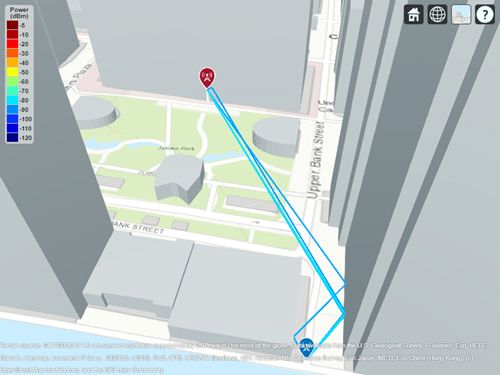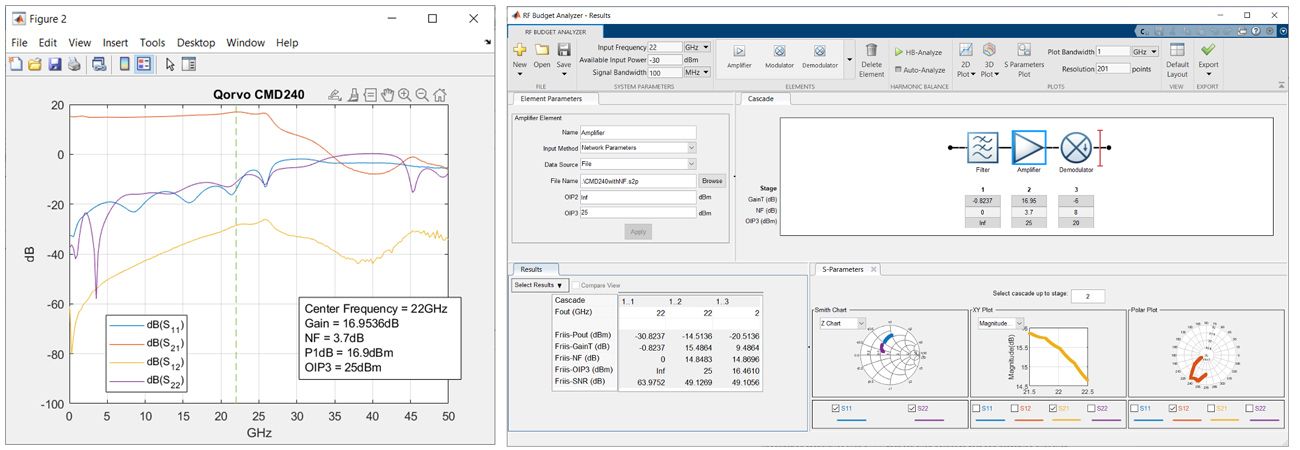What Is mmWave?
The term millimeter wave or mmWave refers to a part of the radio frequency spectrum approximately between 20 GHz and 100 GHz, which has a very short wavelength. This section of the spectrum is lightly used, so the recent allocation of 3GPP FR2 and FR3 bands has generated interest in using mmWave technology for increasing the available bandwidth and capacity of 5G and 6G communications systems.
Designing systems at millimeter wave frequencies is challenging because of increased path loss, reduced scattering that limits diversity, a more pronounced effect of noise due to the usage of larger bandwidths, and limited power budget and transmitter linearity. A good understanding of the mmWave propagation channel is required to mitigate these effects using innovative approaches for the design of antenna arrays and RF front ends. In the following sections you will find details about:
- Design of antennas and arrays for mmWave MIMO systems
- Broadband design and analysis of RF front ends and transceivers
- mmWave channel modeling using ray tracing techniques
Antenna and Array Design for mmWave Systems
Antenna and arrays designed to operate at millimeter wave frequencies have a higher resonant frequency and a smaller wavelength compared to the same antenna operating in the sub-6 GHz range. Therefore, mmWave antennas have smaller geometrical dimensions and arrays are very compact.
At millimeter wave frequencies, antennas can be tightly packed together to create highly directional beamforming systems that effectively compensate for the higher attenuation caused by atmospheric absorption. As a result, most mmWave systems have a MIMO architecture to achieve a throughput comparable—or even higher—than systems operating at lower frequencies. For example, Otava developed and modeled a 5G mmWave beamformer integrated circuit with MATLAB® and Simulink®.
When integrating mmWave antenna arrays, it is important to accurately estimate effects such as mutual coupling and leakage caused by the close proximity of antenna elements. If the signals received are highly correlated, the array will function like one large antenna, which makes beam steering much less effective, as shown in the Effect of Mutual Coupling on MIMO Communication example. Applying the principle of superposition to the isolated antenna element—often done at lower operating frequencies—will neglect coupling and therefore might inaccurately model mmWave arrays, as shown in the Modeling Mutual Coupling in Large Arrays Using Infinite Array Analysis example.
Additionally, mmWave front ends are often designed to operate across very large simulation bandwidths, in the range of hundreds of megahertz and even gigahertz. When designing antenna arrays over such large bandwidths, it is important to accurately estimate the impedance and far field radiation pattern over the entire frequency range as shown in the Model RF Systems with Antenna Arrays Using RF Blockset Antenna Block example. Due to the frequency dependency of the pattern, the array could be affected by beam squinting. In other words, the beam pointing angle could undesirably change as a function of the signal frequency.
Design of RF Front Ends and Transceivers at mmWave Frequencies
The design of mmWave front ends and transceivers is challenging because of dispersion and losses combined with constrained power budgets. To anticipate and mitigate undesired effects before lab prototyping, accurate mmWave behavioral models and dedicated simulation techniques are needed, as shown in this video.
Frequency-dependent impedance mismatches between RF components cannot be neglected, as they can easily reduce the available power budget by several dB. Additionally, impedances can also affect the overall noise margin, further reducing the available SNR. For these reasons, S-parameter data is necessary for modeling and analyzing RF and mmWave components.
At mmWave frequencies, passive components such as filters, matching and feed networks are implemented using distributed elements such as transmission lines, stubs, and resonant structures. The analysis of such elements requires electromagnetic techniques to estimate dispersion, radiation, and efficiency.
For mmWave components such as amplifiers and mixers, nonlinear effects as a function of frequency must be accurately modeled, as they might lead to in-band spectral regrowth or become an undesired source of interference for other systems. Additionally, the large operating bandwidth and the limited selectivity of mmWave receivers make them more susceptible to interferer desensitization.
Dispersion and memory effects also impact power amplifiers at mmWave frequencies. The combined effects of memory and nonlinearity can be mitigated with linearization techniques such as DPD. However, at mmWave these algorithms are hard to test and prototype, thus requiring accurate broadband models for early system simulation.
Ray Tracing for mmWave Systems
In a millimeter wave system, antenna beamwidths are very narrow, and signal losses are much greater at mmWave frequencies than in the sub-6 GHz range, making the use of mmWave frequencies appealing for 5G and 6G large-capacity multiuser applications. Also, most signal paths are line of sight, and multipath plays a less important role at mmWave frequencies than at traditional cellular frequencies. Because of these increased losses, beamforming becomes essential at mmWave. Beyond that, massive MIMO will be essential at these frequencies.
Ray tracing is an important modeling technique for mmWave systems. Since such systems incur less diffuse multipath than sub-6 GHz systems, ray tracing approximates the actual mmWave channel better than a cluster delay line model or a tapped delay line model. Ray tracing requires accurate modeling of the local environment, including terrain and buildings. MATLAB enables easy building import into an RF modeling scenario using OpenStreetMap®. When performing mmWave ray tracing with imported building data, it is important to specify the building materials, as different materials affect the power losses and polarizations of the radiated waves differently. MATLAB enables you to specify a variety of materials, or even to specify the materials’ electric properties without explicitly specifying the materials.
When performing ray tracing at mmWave frequencies, point-to-point and coverage analyses can predict the performance of single links and networks, respectively. A point-to-point analysis can indicate the relative attenuation between line-of-sight and reflected paths. The figure below shows the results of such a mmWave analysis.

Point-to-point ray tracing analysis of a mmWave propagation scenario.
A coverage analysis can predict the overall performance of a communications network in a local geographic area. The figure below shows the results of such a mmWave analysis.

Coverage analysis of a mmWave propagation scenario, created with the Communications Toolbox ray tracing engine.
For details on products that enable mmWave modeling and simulation, see Communications Toolbox™, RF Blockset™, RF Toolbox™, Antenna Toolbox™, RF PCB Toolbox™, 5G Toolbox™, and Phased Array System Toolbox™.
Examples
Antenna and Array Designs
RF Front Ends
Ray Tracing
Software Reference
See also: channel model, RF system, S-parameter, wireless transceiver design, Satellite Communications Toolbox





